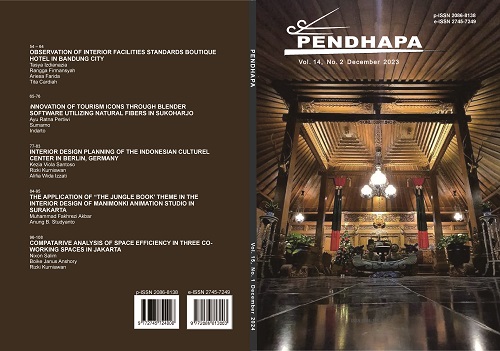Interior Design Planning of the Indonesian Cultural Center in Berlin, Germany
DOI:
https://doi.org/10.33153/pendhapa.v14i2.5205Abstract
Indonesia is renowned for its rich cultural heritage, yet the global appreciation and understanding of this cultural wealth remain limited. This study addresses the challenge of enhancing international recognition and appreciation of Indonesian culture through the establishment of the Indonesian Cultural Center in Berlin, Germany. The primary objective is to develop an interior design concept that effectively introduces and represents Indonesian culture within a European context. Employing qualitative research methods, including observation, interviews, and surveys, the study focuses on the Embassy of the Republic of Indonesia in Berlin, which serves as the project's location. The research includes comparative analyses of various cultural centers and gathers insights from a diverse group of respondents. Results reveal that a well-curated interior design, incorporating elements such as traditional Indonesian materials, colors, and motifs, can significantly attract and engage German audiences. This study concludes with recommendations for spatial design strategies that balance cultural authenticity with local preferences, aiming to foster greater appreciation of Indonesian culture abroad.
Downloads
References
Abbondanza, G. (2022). Whither the Indo-Pacific? Middle power strategies from Australia, South Korea and Indonesia. International Affairs, 98(2), 403–421. https://doi.org/10.1093/ia/iiab231
Beeson, M., Bloomfield, A., & Wicaksana, W. (2021). Unlikely allies? Australia, Indonesia and the strategic cultures of middle powers. Asian Security, 17(2), 178–194. https://doi.org/10.1080/14799855.2020.1846525
Celadyn, M. (2019). Interior Architectural Design for Adaptive Reuse in Application of Environmental Sustainability Principles. Sustainability, 11(14), 3820. https://doi.org/10.3390/su11143820
Celadyn, M. (2020). Integrative Design Classes for Environmental Sustainability of Interior Architectural Design. Sustainability, 12(18), 7383. https://doi.org/10.3390/su12187383
Choi, K. (2019). The Republic of Korea’s public diplomacy strategy: History and current status. Los Angeles: USC Center on Public Diplomacy. https://uscpublicdiplomacy.org/sites/uscpublicdiplomacy.org/files/The%20Republic%20of%20Korea's%20Public%20Diplomacy%20Strategy%20Web%20Ready_2.3.19.pdf
Cohen, M. I. (2019). Three Eras of Indonesian Arts Diplomacy. Bijdragen Tot de Taal-, Land- En Volkenkunde / Journal of the Humanities and Social Sciences of Southeast Asia, 175(2–3), 253–283. https://doi.org/10.1163/22134379-17502022
Dell’Ovo, M., Dell’Anna, F., Simonelli, R., & Sdino, L. (2021). Enhancing the cultural heritage through adaptive reuse. A multicriteria approach to evaluate the Castello Visconteo in Cusago (Italy). Sustainability, 13(8), 4440. https://doi.org/10.3390/su13084440
Grincheva, N. (2019). Global Trends in Museum Diplomacy: Post-Guggenheim Developments. Routledge. https://www.taylorfrancis.com/books/mono/10.4324/9781351190275/global-trends-museum-diplomacy-natalia-grincheva
Lewicki, A. (2022). The material effects of Whiteness: Institutional racism in the German welfare state. The Sociological Review, 70(5), 916–934. https://doi.org/10.1177/00380261221108596
Patton, L. D. (2023). Culture centers in higher education: Perspectives on identity, theory, and practice. Taylor & Francis. https://books.google.com/books?hl=en&lr=&id=8hHJEAAAQBAJ&oi=fnd&pg=PT8&dq=Culture+centers+in+higher+education:+Perspectives+on+identity,+theory,+and+practice&ots=KogYvrn-pV&sig=9lpVyuB3MiUr78KMQ1PyQtBbJRc
Putra, T. K., Rochsantiningsih, D., & Supriyadi, S. (2020). Cultural representation and intercultural interaction in textbooks of English as an international language. Journal on English as a Foreign Language, 10(1), 168–190. https://doi.org/10.23971/jefl.v10i1.1766
Seyfi, S., Hall, C. M., & Rasoolimanesh, S. M. (2020). Exploring memorable cultural tourism experiences. Journal of Heritage Tourism, 15(3), 341–357. https://doi.org/10.1080/1743873X.2019.1639717
Shen, W. (2020). Inheritance and application of traditional arts and crafts in interior decoration design. Conference on Social Science and Modern Science, 622–625. http://proceedings-online.com/proceedings_series/SH-SOCIALS/SSMS2020/icess23031.pdf
Sitohang, S. A., & Fadilla, N. (2023). People and Culture: Human and Cultural History, Human in Diversity of Cultures and Civilizations, Human and Source of Living. International Journal of Students Education, 381–387. https://doi.org/10.62966/ijose.v1i2.453
Thamrin, D., Wardani, L. K., Sitindjak, R. H. I., & Natadjaja, L. (2019). Experiential Learning through Community Co‐design in Interior Design Pedagogy. International Journal of Art & Design Education, 38(2), 461–477. https://doi.org/10.1111/jade.12208
Van de Vijver, F. J., & Leung, K. (2021). Methods and data analysis for cross-cultural research (Vol. 116). Cambridge University Press.
Welsch, H. (2022). What Shapes Satisfaction with Democracy? Interests, Morals, and the German East–West Divide. Social Indicators Research, 163(1), 197–217. https://doi.org/10.1007/s11205-022-02893-x
Yeoh, B. S. (2020). The global cultural city? Spatial imagineering and politics in the (multi) cultural marketplaces of South-east Asia. Culture-Led Urban Regeneration, 102–115.
Zuo, H., & Lu, P. (2021). Investigation and Design Innovation of Color, Materials, and Finish for Civil Aircraft Interiors. The International Journal of Designed Objects, 15(2), 21.
Downloads
Published
Issue
Section
License
Copyright (c) 2024 Kezia Viola Santoso, Rizki Kurniawan, Alifia Wida Izzati

This work is licensed under a Creative Commons Attribution-ShareAlike 4.0 International License.
Authors who publish with Pendhapa agree to the following terms:
- Authors retain copyright and grant the journal right of first publication with the work simultaneously licensed under a Creative Commons Attribution License (CC BY-SA 4.0) that allows others to share the work with an acknowledgment of the work's authorship and initial publication in this journal.
- Authors are able to enter into separate, additional contractual arrangements for the non-exclusive distribution of the journal's published version of the work (e.g., post it to an institutional repository or publish it in a book), with an acknowledgment of its initial publication in this journal.
- Authors are permitted and encouraged to post their work online (e.g., in institutional repositories or on their website) prior to and during the submission process, as it can lead to productive exchanges, as well as earlier and greater citation of published work.

This work is licensed under a Creative Commons Attribution-ShareAlike 4.0 International License.









